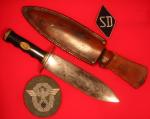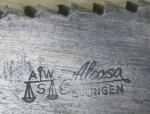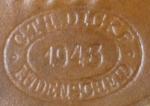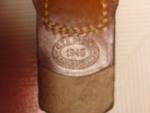-
Posts
102 -
Joined
-
Last visited
Content Type
Profiles
Forums
Blogs
Gallery
Events
Store
Everything posted by JoeW
-
Is anyone reading this thread anymore? I wanted to remark that an August 1944 Gau Verordnungsblatt remarked that long service medal production was restricted, but that a quantity was being provided in the Gau for presentation to families of party members qualifying but who had died before the enemy. Qualified living party members were receiving a notice (Einklebezettel) for their party books and a length of appropriate ribbon.
-
A bit late to the party. Unfortunately the tunic set in the link is not for the Feuerschutzpolizei. It is a more common blue cloth set worn by the Feuerwehr- the common Voluntary Fire Department. The Feuerschutzpolizei were issued police green tunic, pants and visor with pink piping and black facings. Adjust your prices accordingly.
-

Water Police - SS
JoeW replied to Robin Lumsden's topic in Germany: Third Reich: Uniforms, Headwear, Insignia & Equipment
Same weapons as the rest of the police like the Schupo or Gendarmerie. The Water Police was a sub-branch of the Schupo. K98a rifles, P08s, small caliber pistols were issued senior NCOs or purchased by officers. Boat were equipped with Maxims, though I have a photo of a Water Police patrol boat that sported a Villa-Perosa light machine gun. -

Staatspolizei Badge/ID
JoeW replied to RNLSGC's topic in Germany: Third Reich: Uniforms, Headwear, Insignia & Equipment
Any property or identity disc for a governmental organization such as the Gestapo or Kripo bearing an issue mark of the RZM has to be questionable if not outright fake. -
Rick, they were listed under Schupo because the Wasserschutzpolizei was a branch of the Schupo. Its official abbreviation of SW indicated Schutzpolizei Wasser. I agree that the senior officer ranks showed more and more SS-Police ranks as the war progressed. But at the same time, many of the police background general officers, even with SS membership, were taking retirement and bailling out of the sinking ship. Political reliability was a necessity, so Himmler looked to non-police background men for the vacant positions. Yet there was a new wave of young policemen ready to assume the helm, graduates of Tolz and Braunschweig, many of whom were in combat batallions. They were trained in police duties after Tolz and Braunschweig and would have filled the void.
-

Who signed this?
JoeW replied to Chris Boonzaier's topic in Germany: Third Reich: Uniforms, Headwear, Insignia & Equipment
The RRL is alphabetized by ranks, isn't yours? -

SS? Police? Sword
JoeW replied to Rod's topic in Germany: Third Reich: Uniforms, Headwear, Insignia & Equipment
Rod, the SS-Police swords have received quite a bit of attention in published literature over the past thirty years. Most recently by Thomas Wittman in his work on SS blades. But I think perhaps you misunderstood Robin's comments? The rune mark used by WKC was similar to the "runes in diamond" mark seen on other officer and NCO blades. The mark was called a "Warrenzeichen" by the SS and indicated production according to standards established by the RFSS and Chief of the German Police. It did not signify the sword was sold only to an SS member. I had written for Tom Johnson at one time that I thought the Warrenzeichen was a means of limiting production of the SS-Police swords in order to secure a kick-back for the SS from approved manufacturers. Your police NCO sword came with an SS NCO knot and that suggests the SS membership. Just like putting an officers knot on an SS-Police officer's sword would suggest SS membership. It is the knot that suggests membership in the SS, not the runes on the sword. -
I think they are just older reservists being trained for duty by an NCO. They are German police, not Hilfspolizei from the east. They wear the police insignia on the overseas cap as well as the sleeves. The collar insignia and dark uniforms might be older Prussian re-used material. Notice they are using Kar 98a rifles.
-
Return of Germany's colonies was in Hitler's plans. And a police force would be necessary to administer them. Himmler ordered the schools opened, at Oranienburg for the ORPO and Charlottenburg for the SIPO. The daggers were identical to standard issue PAI weapons except for the signature of General Maraffa, the commander of the PAI. There were special instances of the daggers being given for ceremonial occasions, usually with ivory handles and fancier scabbards to the likes of v. Epp, Heydrich and Zindel.I wrote a very nice documented article on this dagger with many photos a few years ago in Roger Bender's magazine "The Military Advisor". Here is a rather severely cropped class photo of one of the SIPO classes with their daggers.
-
This is an unusual presentation dagger awarded to select members of the Ordnungspolizei and Sicherheitspolizei who had graduated from the Colonial police school in Oranienberg and the finishing course at the Italian Colonial Police (PAI) School in Tivoli. The daggers were of Pugnali design used by PAI forces in their colonies and embellished with the signature of PAI General Maraffa. Approximately 400 officers and some enlisted men were allowed to take the finishing course in Italy from 1940 through 1942.
-
Are there any machetes known to have a LW acceptance stamp? The machete in the Die Woche photo spread did not have a frog on the scabbard. Or perhaps the LW purchased on the commercial market for the emergency kits and didn't bother procurement/acceptance? But the Survival drillings are LW accepted. I imagine the police accepted machetes were for the survival kits of their air crews.
-
Here is a photo of the logo of my sawtooth variation. The steel handle variations are not common either. The article I cited above showed a steel handle machete in the canvas frog that was credited to the collection of Patrick Caldwell. Norwest78, do you know if perhaps that was the source of your example? Is it marked with a LW acceptance stamp? Francois, do your brass examples bear any acceptance markings for the LW? My steel version is unmarked, so it was used for commercial purposes or......?
-
Francois, perhaps it would be good to provide the source of the information and photo from the "Die Woche" photo you provided above? Ltc. Thomas Johnson published it in his book Collecting the Edged Weapons of the Third Reich Volume III, page 103-104. Notice the Alcoso trademark variations. Can the manufacture be dated from the use of AWS or ACS? Here is another variation of the steel handle model shown by norwest78 in this thread: http://gmic.co.uk/index.php?showtopic=24518&hl=machete Mine is has a very worn steel handle but the blade has a saw tooth back like the butcher bayonets of WWI. The frog is leather and appears to be Dutch from markings on the reverse.
-

Police Reference books
JoeW replied to Paul R's topic in Germany: Third Reich: Uniforms, Headwear, Insignia & Equipment
Book:Die Generale d. W-SS u.d.Polizei I would recommend this series to anyone interested in serious information about the generals of the Waffen SS and the German Police. Volume 3 has been released covering named generals La-Pl. The series Deutschlands Generale und Admirale Teil V is published by Biblio-Verlag * Bissendorf. Each volume includes a complete biography of these generals and most include photographs, and also feature corrections and updates of prior volumes. The German language volumes have high production values. -

1943 Water/Harbour Police
JoeW replied to Ben's topic in Germany: Third Reich: Uniforms, Headwear, Insignia & Equipment
Rob, I am not disagreeing with Ben's premise. I only asked if any '44 dated tabs have been seen. I haven't seen any. But I have seen unmarked ones on late war cast zinc police buckles. With the scarcity of '43 and absence of later dates, it certainly seems logical that the police stopped using dated tabs in '43/'43. I still believe the off-set digits is best explained by an advancing dater on the logo machine. Stamping by hand would be archaic. What about buckles from the other services? -

1943 Water/Harbour Police
JoeW replied to Ben's topic in Germany: Third Reich: Uniforms, Headwear, Insignia & Equipment
Ben, I must admit that although collecting police material for many years, I have never concentrated on the specifics of buckle tabs and dates. I can see the difference in location of the digits as you mention. I would think the stamp used by these companies would have had a dating mechanism with adjustable digits to move on for a new year. This might explain the digits out of sync, rather than explaining it by your suggestion that would be a logistics nightmare if done manually. I would think all this was done by machine. I can see the problem with leather tabs and the leather shortage that Germany was experiencing. I don't recall any 1944 or later dated tabs. Do you have or have you seen examples? Were tabs used on the sheet metal formed buckles? -

1943 Water/Harbour Police
JoeW replied to Ben's topic in Germany: Third Reich: Uniforms, Headwear, Insignia & Equipment
-

1943 Water/Harbour Police
JoeW replied to Ben's topic in Germany: Third Reich: Uniforms, Headwear, Insignia & Equipment
Ben, I'm sorry, but trying to make a picture at 65k is very tiresome. I can't reduce my photo for uploading here. If you want to PM me with your email, I will send you one. -

1943 Water/Harbour Police
JoeW replied to Ben's topic in Germany: Third Reich: Uniforms, Headwear, Insignia & Equipment
Here is a shot of the tab. Sorry, my batteries were failing and I had to shoot quickly.......and out of focus.








